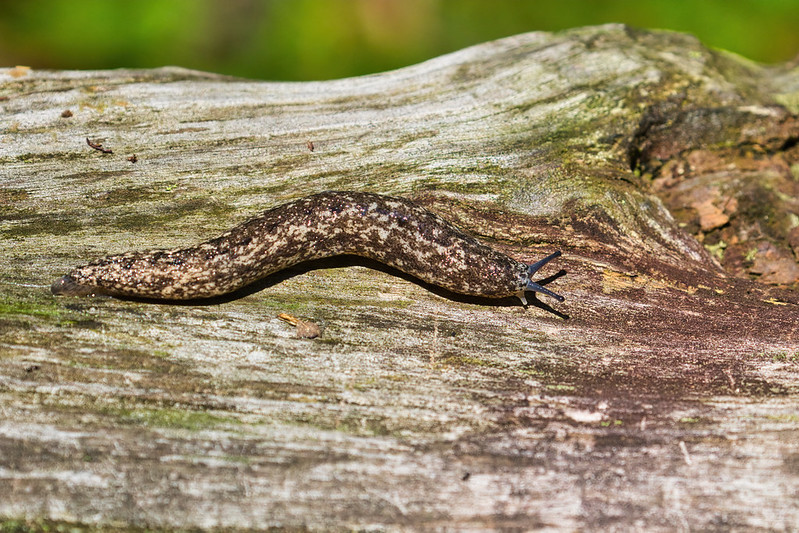If you look closely, you can see that the Land Slug has two pairs of “feelers” or tentacles on their head. The upper pair is light sensing and has eye spots at the ends, while the lower pair provides the sense of smell.

Land slugs are a type of mollusk that lack a hard shell, unlike their relatives the snails. Instead, they have a soft, slimy body that helps them move through the environment and retain moisture. Land slugs are found in a variety of habitats, including forests, gardens, and fields, and are typically active at night, hiding in moist places during the day.
Slugs have a mouth with a radula, which is a rasping tongue-like organ that they use to feed on plant material, fungi, and sometimes small invertebrates. Some species of land slugs are hermaphrodites, meaning that they have both male and female reproductive organs, and can mate with any other individual of the same species.
Land slugs play important roles in the ecosystem by breaking down dead plant material and serving as a food source for a variety of animals, including birds, mammals, and reptiles. However, they can also be considered pests in gardens, where they can consume large amounts of plants.
Overall, land slugs are interesting and important organisms that are often overlooked but play significant roles in the natural world.
Arkansas is home to several species of land slugs. Some of the commonly found species are:
Gray Garden Slug (Deroceras reticulatum) – It is a small, gray-colored slug that is commonly found in gardens and other moist habitats. It feeds on a variety of plants and is considered a pest by many gardeners.
Green Garden Slug (Limax flavus) – This slug is larger than the Gray Garden Slug and has a yellowish-green body. It is also commonly found in gardens and other moist habitats and feeds on plants.
Leopard Slug (Limax maximus) – This species is one of the largest slugs found in Arkansas and has a distinctive pattern of black spots on its yellowish-brown body. It is often found in wooded areas and feeds on decomposing organic matter.
Spotted Slug (Prophysaon andersoni) – This slug is small, brown in color, and has distinctive spots on its body. It is found in moist habitats such as forests and fields and feeds on decaying plant material.
Banded slug (Leidyula floridana) – This slug is dark brown or black in color with a white band running down its back. It is found in wooded areas and feeds on decaying plant material.
These are some of the commonly found land slug species in Arkansas, but there may be others.
Technical:
The log that this Land Slug is on the edge of my driveway. I spotted it while heading out for a photo walk. I photographed the Slug while hand-holding my camera and lens.
• Location: Near the Ouachita National Forest (Arkansas)
• Date Taken: June 27, 2015
• Aperture: f8.0
• Shutter speed: 1/1250 sec.
• ISO: 640
• Exposure Bias: 0 EV
• Exposure Mode: Aperture Priority
• Focal Length: 400 mm
• Lens: Canon EF 100-400 mm f/4.5-5.6 L IS II USM
• Camera: Canon EOS 7D Mark II
